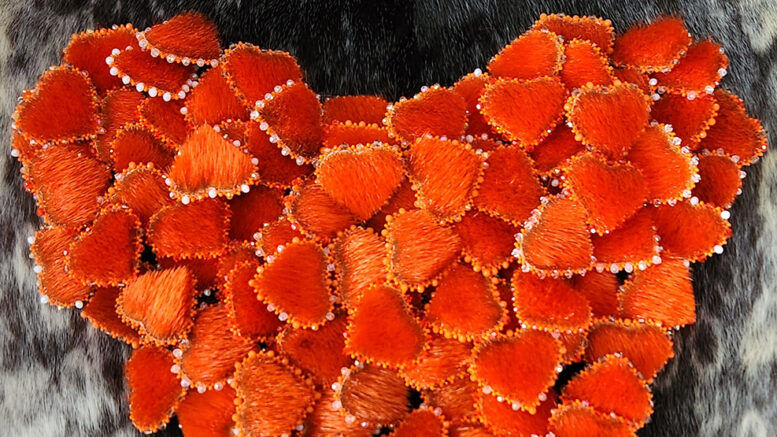By Chevi Rabbit, Local Journalism Initiative Reporter
(ANNews) – Christina King is a well-known Inuvialuk artist and couture fashion designer who owns Taalrumiq Art and Design. She is also a cultural educator and digital content creator from Tuktoyaktuk, Inuvialuit Settlement Region.
In recent years, she has become a celebrity in the Inuvialuit community and has been invited to speak on CBC Radio One’s Unreserved to discuss issues facing Indigenous designers and people.
In addition, she attended and graduated from The Indigenous Haute Couture High Fashion program at the Banff Center for Arts and Creativity, which has allowed her to expand her business and showcase her work across Canada.
Despite being removed from popular e-commerce platform Etsy, King has secured several high-profile contracts for her Sealskin Solidarity Heart pins.
Last year, King participated in Pow Wow Pitch competition, a premier pitch competition and non-profit organization supporting emerging Indigenous entrepreneurs. She won two prizes – the people’s choice award, and the alumni award. She was also one of six emerging Indigenous fashion entrepreneurs to be awarded an Aritzia Indigenous Fashion Grant, which helped to further showcase her work.
“That was exciting, and it challenged me beyond what I thought I could do, and just getting those awards shows me that other people believe in me and what I am doing,” remarked King.
King has been able to feature her art and design work in Winnipeg, Vancouver, and Ottawa, and has had many opportunities to participate in events and fashion shows. Her social media presence has also been steadily growing.
“The product for my pitch was a heart-shaped orange seal skin solitary pin that came about during the 2022 Strong People, Strong Communities, Indigenous Mural art project,” said King. “I was a part of that project on the strong elder’s team, and they approached me about doing a workshop for the public.”
It was during that time they were starting to report on all the children’s graves nationally found at the sites of former Indian residential schools, in Kamloops, and across Canada, explained King.
“I felt that creating the orange heart pin was a meaningful way to address what was happening and just a symbol of love and support for all our residential survivors,” she added. “I am a child of residential school survivors. Both my parents went to residential schools, and my brother and I attended through high school. So, it has so many layers of meaning, and it was a way to heal through traditional arts, using our traditional materials, and gathering together in a safe space to talk, and have these discussions.”
Art and Design Business, Taalrumiq business just grew from there, she said, and she has been busy, recently completing an order to provide 100 pins for conference attendees. She laughed when expressing how difficult it is to add beadwork onto seal skin.
King is also at the forefront of advocating for the Inuit fur trade industry. “I came on Rosanna Deerchild’s show called Unreserved on CBC Radio One to talk about how I use fur in my fashion and to educate about the dwindling fur trade in Canada and the world,” said King.
“A big part of my platform is education and sharing the importance of fur to Inuit and why I use it in my fashion…I tried to sell my mittens and moccasins on the Etsy website, Facebook, and other online platforms, and was viciously attacked online for my use of fur.”
“It was discouraging,” she added.
But she now has a platform, is being heard and work is being appreciated.
It’s a total 180,” said King. “It’s nice that so many other Inuit designers are being fairly compensated now, unlike our grandmothers who gave away their hard work.”
King opens about her grandmothers, “I feel that my grandmothers were exploited for work. My maternal Inuvialuk grandmother is Alice Cockney Gruben of Tuktoyaktuk, NWT, and my paternal Gwich’in grandmother is Eliza Albert Louie of Aklavik, NWT.”
“They were paid so little. My grandmother was a well-known seamstress, she made a pair of handmade seal skins for a Japanese explorer, who was the first explorer to walk to the north pole, and he stayed at my grandparents for a couple of weeks. So, my grandmother took care of him and made him proper clothing for his journey to the north pole… that was huge. And she just gave this stuff away.
“It’s been a struggle to get our work valued and convince consumers why we have the prices set that we do.”
Follow Taalrumiq | Christina King’s work through Linktree or on Instagram @taalrumiq, TikTok @taalrumiq, Facebook @taalrumiq, Twitter @taalrumiq, and YouTube @Taalrumiq Inuvialuk Artist & Designer.



Be the first to comment on "Fashion designer Christina King on the importance of using fur in fashion"